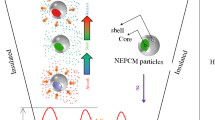Abstract
High-velocity suspension flame spraying (HVSFS) has recently developed as a possible alternative to conventional HVOF-spraying employing liquid suspensions instead of dry powder feedstock enables the use of nanoparticles. From the fluid dynamics point of view, the HVSFS system is complex and involves three-phase (gas, liquid and solid particles) turbulent flow, heat transfer, evaporation of the suspension solvent, chemical reactions of main fuel (propane) and suspension solvent (ethanol) and supersonic/subsonic flow transitions. Computational fluid dynamic techniques were carried out to solve the mass, momentum, and energy conservation equations. The realizable k-ε turbulence model was used to account for the effect of turbulence. The HVSFS process involves two combustion reactions. A primary combustion process is the premixed oxygen-propane reaction and secondary process is the non-premixed oxygen-gaseous ethanol reaction. For each reaction, one step global reaction, which takes dissociations and intermediate reactions into account, was derived from the equilibrium chemistry code developed by Gordon and McBride and eddy dissipation model was used to calculate the rate of reactions based on the transport equations for all species (10 species) mass fractions. Droplets were tracked in the continuum in a Lagrangian approach. In this paper, flow field inside and outside the gun simulated to provide clear and complete insight about the HVSFS processes. Moreover, the effect of some operative parameters (oxy-fuel flow rate, ethanol flow rate, droplets injection velocity and droplets size) on the gas flow field along the centerline and droplets evaporation behavior was discussed.














Similar content being viewed by others
Abbreviations
- R i,r :
-
Net rate of production of species i due to reaction r
- M w,i :
-
Molecular weight of species i
- N :
-
Number of chemical species in the system
- \( \upnu^{\prime}_{i,r} \) :
-
Stoichiometric coefficient for reactant i in reaction r
- \( \upnu^{\prime\prime}_{i,r} \) :
-
Stoichiometric coefficient for product i in reaction r
- Y P :
-
Mass fraction of any product species, P
- Y R :
-
Mass fraction of a particular reactant, R
- K :
-
Turbulence kinetic energy
- Ε:
-
Turbulence dissipation rate
- ρ:
-
Mixture density
- A :
-
Empirical constant equal to 4.0
- B :
-
Empirical constant equal to 0.5
References
S. Siegmann, M. Leparoux, and L. Rohr, Werkstoffe und Werkstofftechnische Anwendungen, Werkstofftechnischen Kolloquium, Chemnitz, 2005, p 314
Z.G. Ban and L. Shaw, Characterization of Thermally Sprayed Nanostructured WC-Co Coatings Derived from Nanocrystalline WC-18wt% Co Powders, J. Therm. Spray Technol., 2003, 12(1), p 112-119
J.R. Davis, Handbook of Thermal Spray Technology, ASM International, Materials Park, OH, 2004
R. Gadow, A. Killinger, and J. Rauch, Introduction to High-Velocity Suspension Flame Spraying, J. Therm. Spray Technol., 2008, 17(5-6), p 655-661
R.W. Smith and R. Knight, Thermal Spraying I: Powder Consolidation from Coating to Forming, J. Met., 1995, 47, p 32-39
V.V. Sobolev and J.M. Guilemany, Dynamic Processes During High Velocity Oxy-Fuel Spraying, Int. Mater. Rev., 1996, 41(1), p 13-32
H. Kreye, Vergleich der HVOF-Systeme—Werkstoffverhalten und Schichteigenschaften, Proceedings of the 4. Kolloquium Hochgeschwindigkeit-Sflammspritzen, 1997, p 13-21
E. Dongmo, R. Gadow, and A. Killinger, Numerical Approach and Optimization of the Combustion and Injection Techniques in High Velocity Suspension Flame Spraying (HVSFS), Thermal Spray 2009: Proceedings of the International Thermal Spray Conference 2009, p 442-449
B. Martinez, G. Mariaux, A. Vardelle, G. Barykin, and M. Parco, Numerical Investigation of a Hybrid HVOF-Plasma Spraying Process, J. Therm. Spray Technol., 2009, 18, p 909-920
J.P. Van Doormal, G.D. Raithby, and B.H. McDonald, The Segregated Approach to Predicting Viscous Compressible Fluid Flows, ASME J. Turbomach., 1987, 109, p 268-277
M. Peric, Analysis of Pressure-Velocity Coupling on Non-Orthogonal Grids, Numer. Heat Transf. B, 1990, 17, p 63-82
G.D. Raithby and G.E. Schneider, Numerical Solution of Problems in Compressible Fluid Flow: Treatment of the Velocity-Pressure Coupling, Numer. Heat Transf., 1979, 2, p 417-440
B.E. Launder and D.B. Spalding, Lectures in Mathematical Models of Turbulence, Academic Press, London, 1972
B.P. Stephen, Turbulent Flows, Cambridge University Press, New York, 2001
T.H. Shih, W.W. Liou, A. Shabbir, Z. Yang, and J. Zhu, A New Eddy Viscosity Model for High Reynolds Number Turbulent Flows Model Development and Validation, Comput. Fluids, 1995, 24(3), p 227-238
S.A. Morsi and A.J. Alexander, An Investigation of Particle Trajectories in Two-Phase Flow Systems, J. Fluid Mech., 1972, 55, p 193-208
H. Tabbara and S. Gu, Computational Simulation of Liquid Fuelled HVOF Thermal Spraying, J. Surf. Coat. Technol., 2009, 204(5), p p676-684
S. Gordon and B.J. McBride, Computer Program for Calculation of Complex Chemical Equilibrium Compositions and Applications, NASA Reference Publication No. 1311, Lewis Research Center, Cleveland, OH, October 5 1994
S. Kamnis and S. Gu, 3-D Modeling of Kerosene-Fuelled HVOF Thermal Spray Gun, J. Chem. Eng. Sci., 2006, 61, p 5427-5439
S. Kamnis and S. Gu, Numerical Modeling of Propane Combustion in a High Velocity Oxygen-Fuel Thermal Spray Gun, J. Chem. Eng. Process., 2006, 45, p 246-253
T. Furuhata, S. Tanno, T. Miura, Y. Ikeda, and T. Nakajima, Performance of Numerical Spray Combustion Simulation, Energy Convers. Manage., 1997, 38(10-13), p 1111-1122
P.O. Witze, Centerline Velocity Decay of Compressible Free Jets, AIAA J, 1974, 12, p 417-418
C. Chu, A Simple Analytical Method for Predicting Axisymmetric Turbulent Jet Flow Fields in a Free stream, AIAA J, 1985, 35, p 1-9
J.C. Lau, P.J. Morris, and M.J. Fisher, Measurements in Subsonic and Supersonic Free Jets Using a Laser Velocimeter, J. Fluid Mech., 1979, 93(1), p 1-27
Author information
Authors and Affiliations
Corresponding author
Rights and permissions
About this article
Cite this article
Taleby, M., Hossainpour, S. Numerical Investigation of High Velocity Suspension Flame Spraying. J Therm Spray Tech 21, 1163–1172 (2012). https://doi.org/10.1007/s11666-012-9802-x
Received:
Revised:
Published:
Issue Date:
DOI: https://doi.org/10.1007/s11666-012-9802-x




